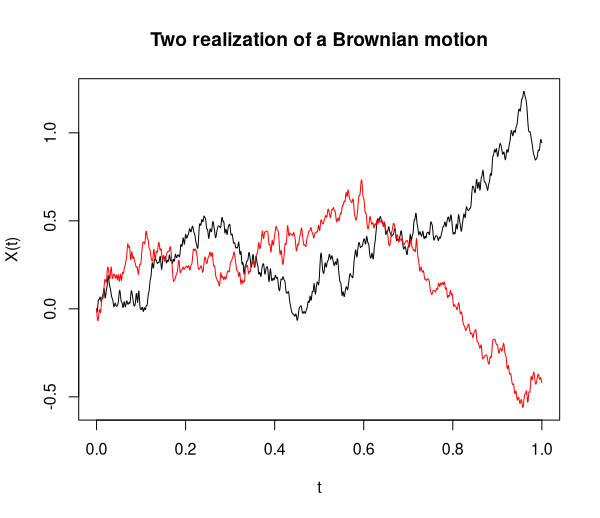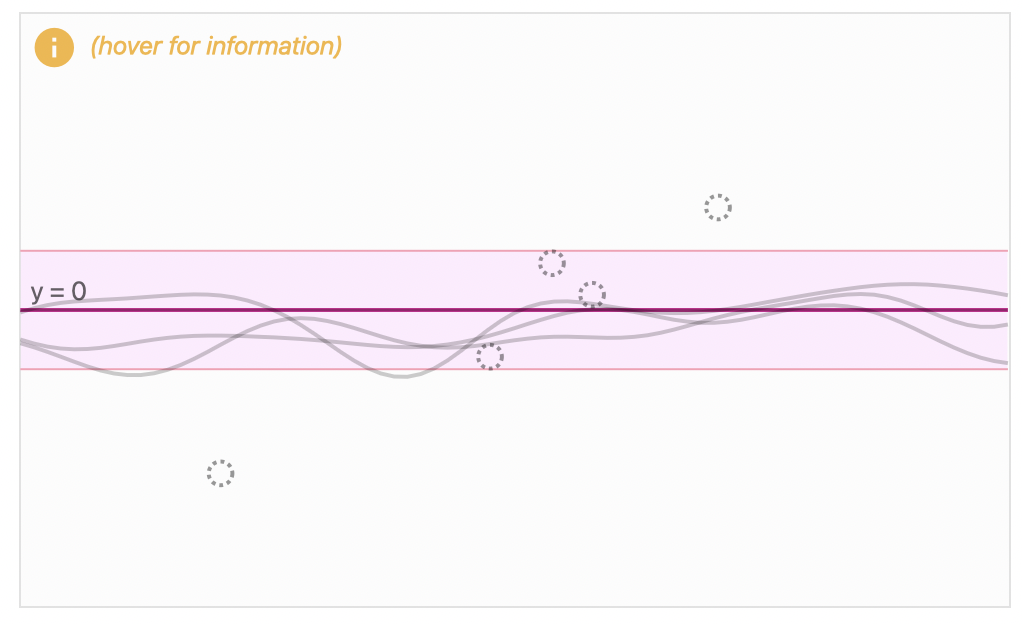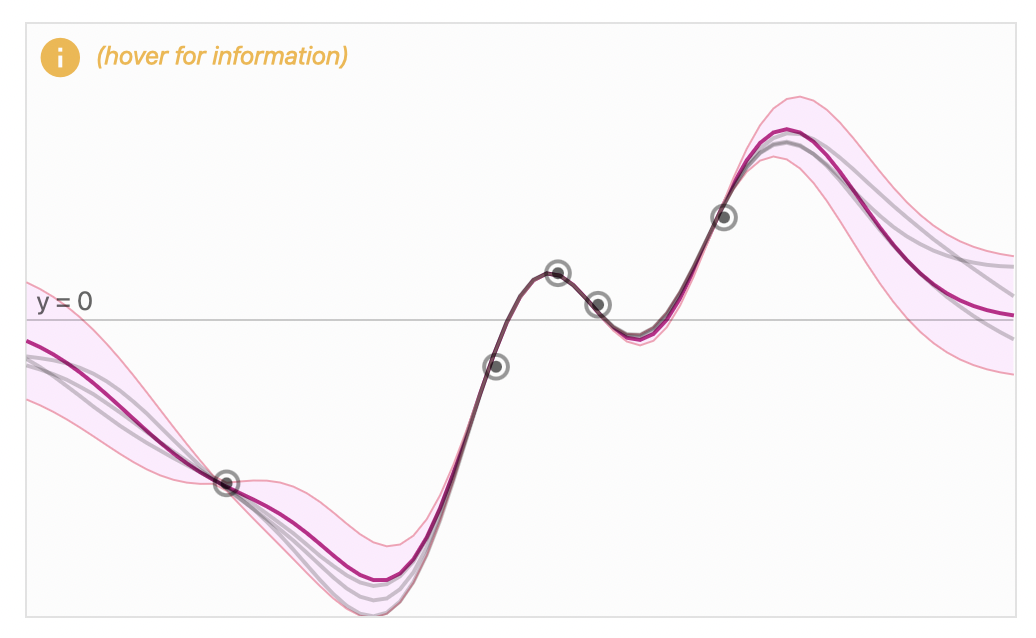A stochastic process $X(t), t \in T$ is a Gaussian process (GP) if $\sum_i a_i X(t_i)$ is a Gaussian random variable for any such linear combination. Equivalently, it is a GP if all its finite-dimensional distributions are (multivariate) Gaussian, that is $(X(t_1),X(t_2),\dots,X(t_n))$ is Gaussian for any choice of $\{t_i\}$. Usually, one in addition requires that the sample path $t \mapsto X(t)$ be continuous. This way you can view a GP as a random function in $C(T)$ the space of all continuous functions on $T$.
A GP is characterized by a mean function $\mu: T \to \mathbb R$ and a covariance kernel $K$ (a positive semi definite function from $T \times T$ to $\mathbb R$) with the property that $\mathbb E [X(t)] = \mu(t)$ for all $t \in T$ and
$$\text{cov}\big(\mathbf X) = (K(t_i,t_j))_{i,j=1}^n$$ where $\mathbf X = (X(t_1),X(t_2),\dots,X(t_n))$ and this holds for any choice of $\{t_1,\dots,t_n\} \subset T$ and any $n \ge 1$. Note that $\mu$ and $K$ effectively specify all those finite-dimensional normal distributions we talked about before.
This is all good, but what does a GP look like? I mean, how do we even sample from a GP and what do the functions we sample from look like? How can we output an entire function every time we sample a single element from GP?
Representation
There is a very powerful result that allows us to give a nice answer to this question. To make it simple, I am not going to worry about mathematical rigor that much (maybe a little bit!). Here are a couple of observations:
Associated to every kernel function $K(\cdot,\cdot)$, there is a unique reproducing kernel Hilbert space (RKHS), call it $H$. Let's not worry what RKHS means, it is just a deterministic space of "nice" functions. We can view $H$ as a subset of the $L^2$ space of functions on $T$.
Thus associated to every GP, there is an RKHS determined by its covariance kernel. It turns out that the closure of $H$ (in $C(T)$) is the support of the GP, that is, $P( X \in \bar H) = 1$. We will never observe anything outside $\bar H$ when we sample from the GP.
Let $\{\phi_j\}_{j \in \mathbb N}$ be a complete orthonormal system of eigenfunctions of the kernel matrix $K(\cdot,\cdot)$ (in $L^2$) and $\{\lambda_j\}_{j \in \mathbb N}$ the corresponding nonzero eigenvalues. We assume they are ordered as follows:
$$
\lambda_1 \ge \lambda_2 \ge \lambda_3 \ge ...
$$
and they are all nonnegative (a consequence of positive semi-definiteness.) If $H$ is infinite-dimensional, this sequence will also be infinite.
You might have heard of the Mercer's theorem which gives an expansion of the kernel in terms of these:
$$
K(s,t) = \sum_{j=1}^\infty \lambda_j \phi_j(s) \phi_j(t).
$$
- It turns out that the associated GP also has an expansion in terms of those eigenfunctions: Then, almost surely
$$
X(t) = \mu(t) + \sum_{j=1}^\infty \sqrt{\lambda_j} g_j \phi_j(t). \quad (*)
$$
where $g_i \sim N(0,1), i =1,2,3,\dots$ i.i.d. standard normal variables.
This is called a Karhunen–Loève expansion. Since $\lambda_j \to 0$ as $j \to \infty$, you can truncate this series to some large value of $N$ and get a good approximation. Basically, a GP is a linear combination of these eigenfunctions with random weights $\sqrt{\lambda_j} g_j$ (which are drawn independently from a Gaussian distribution with zero mean and variance $\lambda_j$). You can think of these eigenfunctions as the directions of variation of the GP. There is more variability along $\phi_1$ followed by $\phi_2$ and so on. (Think of it like PCA in infinite dimensions.)
Representation (*) is good enough for understanding and you can just stop here. But the story doesn't end here. See the end of this post. To practically sample from the GP, find $\{\phi_j\}$ and $\lambda_j$, draw $\{g_j\}$ as i.i.d. standard normal variables and form $X(t) \approx \sum_{j=1}^N \sqrt{\lambda_j} g_j \phi_j(t)$ for some large enough $N$.
Example
Consider the Brownian motion on $[0,1]$ which is a centered sample-path-continuous GP with covariance matrix $\mathbb E [X(t) X(s)] = \min\{t,s\}$ for all $s,t \in [0,1]$. The eigenvalues and eigenfunctions are given by (see Example 12.23 in Wainwright's book)
$$
\phi_j(t) = \sin \frac{(2j-1)\pi t}{2}, \quad \lambda_j = \Big( \frac{2}{(2j-1)\pi}\Big)^2.
$$
Note that $\lambda_j \to 0$ as $j \to \infty$. Then, if you believe the K-L result, we can give a explicit construction of the Brownian motion as follows:
$$
X(t) = \sum_{j=1}^\infty \frac{2 g_j}{(2j-1)\pi} \, \sin \left( \frac{(2j-1)\pi t}{2}\right) = \sum_{k \; \text{odd}} \frac{2 g_k}{k\pi} \, \sin \left( \frac{k\pi t}{2}\right).
$$
where $g_1, g_2, g_3, \dots \stackrel{\text{i.i.d.}}{\sim} N(0,1)$.
Here is some code to draw two samples from this random function:
tvec = seq(0,1, length.out = 1000)
N = 500
set.seed(125)
g1 = rnorm(N)
g2 = rnorm(N)
X_realization = function(tvec, g) {
sapply(tvec, function(t) sum( sapply(1:N, function(j) 2*g[j]*sin((2*j-1)*pi*t/2)/(pi*(2*j-1)))) )
}
Xs1 = X_realization(tvec, g1)
Xs2 = X_realization(tvec, g2)
yrange = range(cbind(Xs1, Xs2))
plot(tvec, Xs1, type="l", ylim = yrange, main = "Two realizations of a Brownian motion", xlab = "t", ylab = "X(t)")
lines(tvec, Xs2, col="red")
And the resulting plot:

The rest of the story
It turns out that any complete orthonormal system of $H$ will do. So if you pick any sequence of functions $\{h_j\}$ that are orthonormal in $H$ and their closure spans the entire $H$, then, almost surely
$$
X(t) = \sum_{j=1}^\infty g_j h_j,
$$
where $\{g_j\}$ is some i.i.d. $N(0,1)$ sequence. This gives much flexibility in representing a GP and some basis might work better than the other in a specific application. (See Theorem 2.6.10 in Giné and Nickl's book).
In finite dimensions
EDIT: Since this post got some attention, let me add this too. The K-L expansion mentioned above is not unfamiliar to you if you have thought about how to sample a general multivariate Guassian vector $\mathbf x \sim N(\mu, \Sigma)$. What you would generally do is to write $\mathbf x = (x_i) = \mu + \Sigma^{1/2} \mathbf z \in \mathbb R^n$ where $\mathbf z \sim N(0,I)$ that is $\mathbf z = (z_i)$ with $z_1,\dots,z_n$ i.i.d. $\sim N(0,1)$ and $\Sigma^{1/2}$ is the matrix square root of $\Sigma$.
Another closely related approach is to perform eigen-decompisition on $\Sigma = U \Lambda U^T$ where $U = [\mathbf u_1 \mid \mathbf u_2 \mid \cdots \mid \mathbf u_n]$ is an orthogonal matrix whose columns are the eigenvectors of $\Sigma$ and $\Lambda = \text{diag}(\lambda_i)$ is the diagonal matrix of the corresponding eigenvalues. Then, we can generate $\mathbf x = \mu + U \Lambda^{1/2} \mathbf z$ (verify that this has the right distribution!). If you expand this equation you get
$$
\mathbf x = \mu + \sum_{i=1}^n \sqrt{\lambda_i} z_i \mathbf u_i
$$
which is just the finite-dimensional analog of the K-L expansion.



